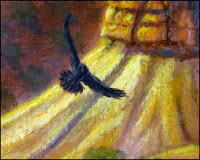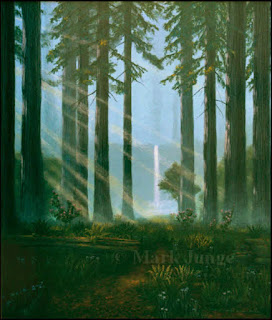Arches and Feathers is a reworking of a painting I "finished" in 2007. As is sometimes the case, it seemed like the painting needed a little tweaking...and finally, I stripped the removable varnish on it and set about to do some tweaking. (And repair a little damage that stripping the varnish caused).
And I think I finally have what I want!
 | ||
| Arches and Feathers 24" x 36" |
 I included a redtail hawk turning and banking to its left. It's in shadow and appears dark (almost black). Placing it against the brightly-lit rocks created a focal point that draws the eye into the composition.
I included a redtail hawk turning and banking to its left. It's in shadow and appears dark (almost black). Placing it against the brightly-lit rocks created a focal point that draws the eye into the composition.This little guy wasn't in the first version of the painting -- I think s/he adds a little life and even more mystery to the scene.
Besides, I read of another landscape artist who said he was told by an Indian friend that seeing hawks brings good luck and, if one appears in a painting, it brings good luck in sales! I hope that's true!
I still need to apply the finishing coats of varnish. I hope this will be a good attention-getter at a show I'll be doing in November (more on this later) and that the hawk will bring some luck, too!
SouthwestSpaces.com
MarkJunge.com












